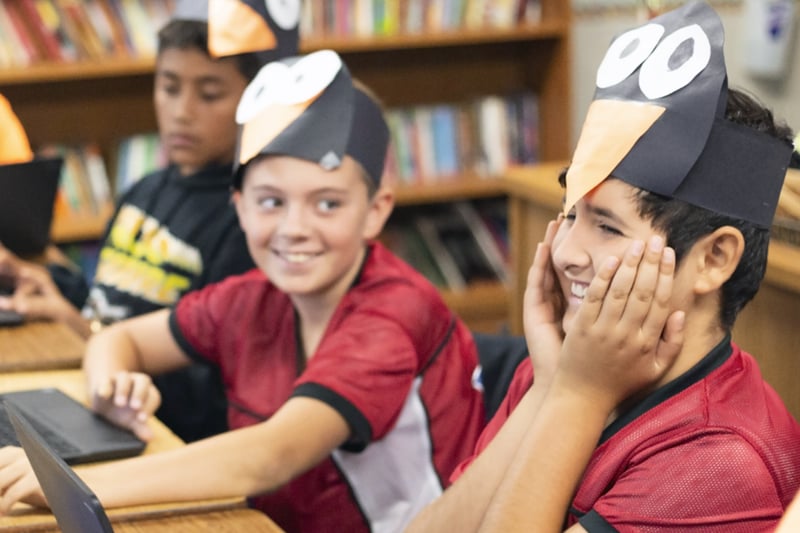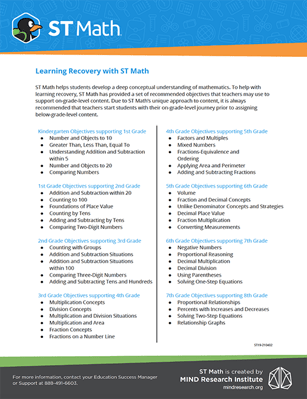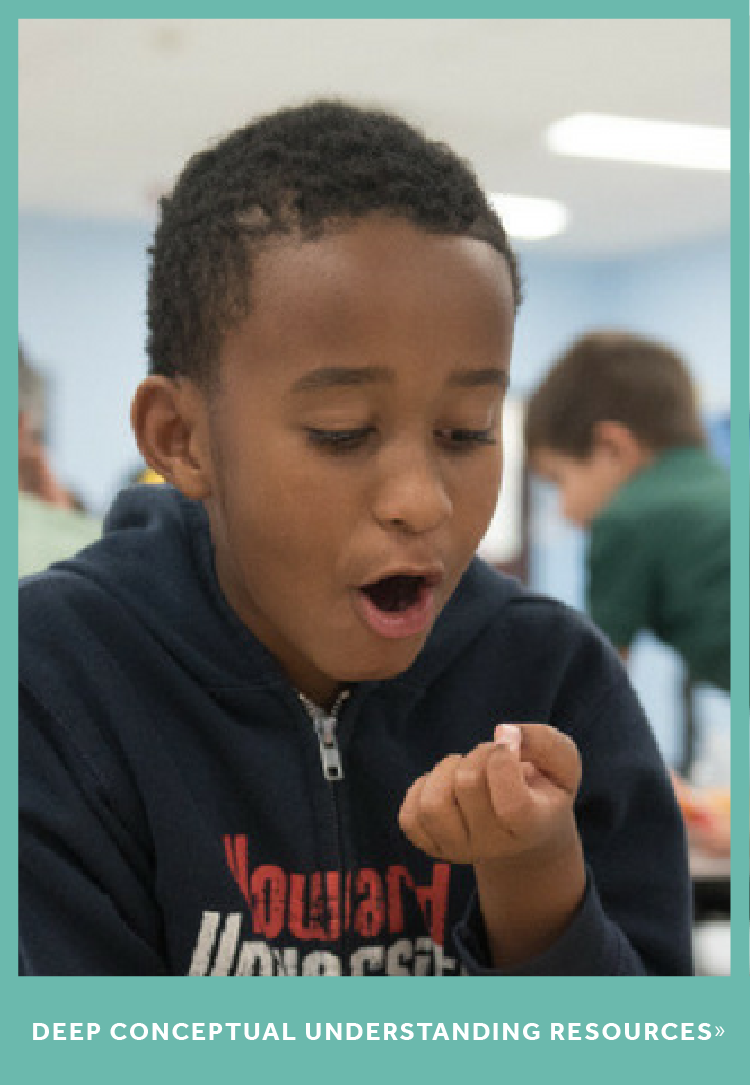
Research on COVID-related school closures suggests that students could be a half, to a full year behind academically when the new school year begins. What many are calling the COVID Slide will have a large impact on what the next school year—and school years to come—will look like. Classrooms and online learning environments will continue to evolve.
The variability of students' individual needs will also be much greater. And curriculum will need to be blended, flexible, and use tools that can be implemented in school and at home.
It’s challenging for all of us. ST Math can help.

Accessible, Adaptive, and On Grade Level
ST Math begins by showcasing math visually, and then gradually introduces symbols and language as students master the basic concepts. Using visual, spatial-temporal models to showcase the math concepts provides students with access to mathematical ideas in ways that words alone cannot achieve.
With visual learning, students are better equipped to tackle unfamiliar math problems, recognize patterns, and build conceptual understanding. When we remove language as a barrier, the problem is accessible to more students, regardless of skill level or language background.
ST Math is self-paced. Students move through the instructional path at their own speed. By applying a mastery-driven approach, each student receives a personalized number of puzzles to solve based on their level of understanding of each topic. This allows students to be presented with the right amount of challenge and support for their level.
Many digital programs use adaptive algorithms to adjust the level of instruction up or down based on students’ right or wrong answers. Typically struggling students get tracked to below grade-level material, and they can get stuck there.
Not so with ST Math. Rather than automatically dropping students down, ST Math starts each concept at a very basic level and gradually increases the level of challenge using scaffolding techniques. Instead of going backwards to experience success, ST Math’s approach enables students to access on-grade-level material in ways not possible with traditional approaches to math instruction. This allows all students to begin on grade level and meaningfully progress through the mastery-driven content at their own pace.
Assignments Offer Even More Support
The new version of ST Math coming for the 2020-2021 school year includes an all-new assignments feature, which gives teachers the ability to select specific ST Math objectives to assign to individual students, small groups, or the whole class. Objectives can come from any grade level, and can be used to augment and fortify conceptual understanding of topics from earlier grade levels, or to challenge students with material from later grade levels.
Educators who have already been using ST Math will find that students won’t replay objectives that they have already mastered in prior grade levels. This ensures that each student gets only the review they need, and is an encouraging indication that the student has developed a deep understanding of the content and is ready to succeed at their grade level in ST Math.
For students who are most impacted by the COVID Slide, it may be beneficial to consider assigning particular content from the prior grade. We always recommend that teachers start students with on-grade-level content, but should students need to deepen conceptual understanding of earlier concepts, the ST Math team has put together a suggested list of objectives for teachers to assign at their discretion:
Kindergarten Objectives supporting 1st Grade
- Number and Objects to 10
- Greater Than, Less Than, Equal To
- Understanding Addition and Subtraction within 5
- Number and Objects to 20
- Comparing Numbers
1st Grade Objectives supporting 2nd Grade
- Addition and Subtraction within 20
- Counting to 100
- Foundations of Place Value
- Counting by Tens
- Adding and Subtracting by Tens
- Comparing Two-Digit Numbers
2nd Grade Objectives supporting 3rd Grade
- Counting with Groups
- Addition and Subtraction Situations
- Addition and Subtraction Situations within 100
- Comparing Three-Digit Numbers
- Adding and Subtracting Tens and Hundreds.
3rd Grade Objectives supporting 4th Grade
- Multiplication Concepts
- Division Concepts
- Multiplication and Division Situations
- Multiplication and Area
- Fraction Concepts
- Fractions on a Number Line
4th Grade Objectives supporting 5th Grade
- Factors and Multiples
- Mixed Numbers
- Fractions-Equivalence and Ordering
- Applying Area and Perimeter
- Adding and Subtracting Fractions
5th Grade Objectives supporting 6th Grade
- Volume
- Fraction and Decimal Concepts
- Unlike Denominator Concepts and Strategies
- Decimal Place Value
- Fraction Multiplication
- Converting Measurements
6th Grade Objectives supporting 7th Grade
- Negative Numbers
- Proportional Reasoning
- Decimal Multiplication
- Decimal Division
- Using Parentheses
- Solving One-Step Equations
7th Grade Objectives supporting 8th Grade
- Proportional Relationships
- Percents with Increases and Decreases
- Solving Two-Step Equations
- Relationship Graphs
 [Download these recommendations on a single page (PDF)]
[Download these recommendations on a single page (PDF)]
Whether educators keep students on grade level content or use the new assignments feature to draw in content from other grade levels, ST Math can make a positive impact for students in mitigating learning loss and regaining ground in the new school year.
Further Reading:

About the Author
Ki Karou is a seasoned expert in game-based learning and visual learning, with a focus on helping learners build mental schema and problem-solve. As the Senior Director of Product at MIND Education, Ki has led a team of learning and game designers, artists, and mathematicians in developing neuroscience-driven ed tech solutions for over a decade. A sought-after speaker and published author, Ki has shared his expertise at events like SXSW EDU and contributed articles to publications including the Huffington Post.





.png)



Comment